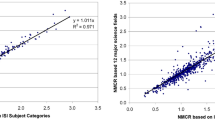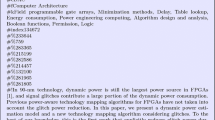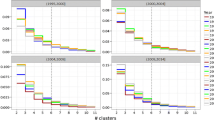Abstract
This article examines the extent to which specific features of interdisciplinary research are accurately reflected in selected bibliometric measures of scholarly publications over time. To test the validity of these measures, we compare knowledge of research processes and impact based on ethnographic studies of a well-established researcher’s laboratory, together with personal interview data, against bibliometric indicators of cognitive integration, diffusion, and impact represented in the entire portfolio of papers produced by this researcher over time.

























Similar content being viewed by others
Notes
VantagePoint: http://www.theVantagePoint.com.
For details of how integration scores I are calculated, see Porter et al. 2008.
t tests were calculated with benefit of: http://www.graphpad.com/quickcalcs/ttest1.cfm.
For more on JIFs, including how they are calculated, see http://thomsonreuters.com/products_services/science/free/essays/impact_factor/.
Benchmark sample sizes are calculated with benefit of: http://www.surveysystem.com/sscalc.htm, using a confidence level of 95 % and confidence interval of ±3.
The top five SCs for Nerem (by record counts), in order of magnitude, are: Engineering, Biomedical (BME), Peripheral Vascular Disease (PVD), Cardiac and Cardiovascular Systems (CCS), Hematology (HEM) and Cell Biology (CBI). We note that the lion’s share (i.e., 63.75 %) of Nerem’s research falls into one or more of these categories.
A Nerem publication with the SC Biomedical Engineering (BME) is said to be affiliated with the BME benchmark.
t tests are calculated with benefit of: http://www.graphpad.com/quickcalcs/ttest1.cfm?Format=SD.
The mean number of cases (i.e., publications) Nerem has for each for the above SC year comparisons is 2.
Nitric oxide synthases (NOSs) are a family of enzymes that catalyze the production of nitric oxide (NO) from l-arginine. NO is an important cellular signaling molecule, having a vital role in many biological processes. It is the intercellular signal that controls vascular tone (hence blood pressure), insulin secretion, airway tone, and peristalsis and is involved in angiogenesis (growth of new blood vessels) and in the development of the nervous system. It is believed to function as a retrograde neurotransmitter and hence is likely to be important in learning. Nitric oxide signalling is mediated in mammals by the calcium/calmodulin controlled isoenzymes eNOS (endothelial NOS) and nNOS (neuronal NOS); the inducible isoform iNOS is involved in immune response, binds calmodulin at all physiologically relevant concentrations, and produces large amounts of NO as a defense mechanism. It is the proximate cause of septic shock and may play a role in many diseases with an autoimmune etiology. “Nitric Oxide Synthase" Wikipedia Web, 24 Nov 2011 (http://en.wikipedia.org/wiki/Nitric_oxide_synthase).
References
Batagelj, V., & Mrvar, A. (1998). Pajek—program for large network analysis. Connections, 21(2), 47–57.
Carley, S., & Porter, A. L. (2012). A forward diversity index. Scientometrics.
De Keulenaer, G. W., Chappell, D. C., Ishizaka, N., et al. (1998). Oscillatory and steady laminar shear stress differentially affect human endothelial redox state—role of a superoxide-producing NADH oxidase. Circulation Research, 82(10), 1094–1101.
Garner, J., & Porter, A. L. (2011). Assessing the human and social dynamics program—exceptional cross-disciplinarity. Atlanta: Proceedings, Atlanta Conference on Science and Innovation Policy.
Ku, D. N. (1997). Blood flow in arteries. Annual Review of Fluid Mechanics, 29, 399–434.
Levesque, M. J., & Nerem, R. M. (1985). The elongation and orientation of cultured endothelial-cells in response to shear-stress. Journal of Biomechanical Engineering Transactions of the ASME, 107(4), 341–347.
Morillo, F., Bordons, M., & Gomez, I. (2001). An approach to interdisciplinarity through bibliometric indicators. Scientometrics, 51, 203–222.
National Academies Committee on Facilitating Interdisciplinary Research, Committee on Science, Engineering and Ublic Policy. (2005). Facilitating interdisciplinary research. Washington: National Academies Press.
Nersessian, N. J. (2009). How do engineering scientists think? Model-based simulation in biomedical engineering research laboratories. Topics in Cognitive Science, 1, 730–757.
Nersessian, N. J., & Patton, C. (2009). Model-based reasoning in interdisciplinary engineering. In A. Meijers (Ed.), Handbook of the philosophy of science. Philosophy of technology and engineering sciences (pp. 687–718). Amsterdam: Elsevier.
Nishida, K., Harrison, D. G., Navas, J. P., et al. (1992). Molecular-cloning and characterization of the constitutive bovine aortic endothelial-cell nitric-oxide synthase. Journal of Clinical Investigation, 90(5), 2092–2096.
Porter, A. L., Cohen, A. S., Roessner, J. D., & Perreault, M. (2007). Measuring researcher interdisciplinarity. Scientometrics, 72(1), 117–147.
Porter, A. L., & Rafols, I. (2009). Is science becoming more interdisciplinary? Measuring and mapping six research fields over time. Scientometrics, 81(3), 719–745.
Porter, A. L., Roessner, J. D., & Heberger, A. E. (2008). How interdisciplinary is a given body of research? Research Evaluation, 17(4), 273–282.
Rafols, I. (2007). Strategies for knowledge acquisition in bionanotechnology: why are interdisciplinary practices less widespread than expected? Innovation. The European Journal of Social Sciences, 20(4), 395–412.
Rafols, I., & Meyer, M. (2007). How cross-disciplinary is bionanotechnology? Explorations in the specialty of molecular motors. Scientometrics, 70(3), 633–650.
Rafols, I., & Meyer, M. (2010). Diversity and network coherence as indicators of interdisciplinarity: case studies in bionanoscience. Scientometrics, 82(2), 263–287.
Stirling, A. (2007). A general framework for analysing diversity in science, technology and society. Journal of the Royal Society Interface, 4(15), 707–719.
Stokols, D., Hall, K. L., et al. (2008). The science of team science—overview of the field and introduction to the supplement. American Journal of Preventive Medicine, 35(2), S77–S89.
Uematsu, M., Ohara, Y., Navas, J. P., et al. (1995). Regulation of endothelial cell nitric oxide synthase mRNA expression by shear stress. American Journal of Physiology Cell Physiology, 269(6), C1371–C1378.
Wagner, C. S., Roessner, J. D., Bobb, K., Klein, J. T., Boyack, K. W., Keyton, J., et al. (2011). Approaches to understanding and measuring interdisciplinary scientific research (IDR): a review of the literature. Journal of Informetrics, 5(1), 14–26.
Acknowledgments
Our grateful thanks to Dr. Robert Nerem for his extremely helpful cooperation during this study. We appreciate the support of the National Science Foundation (Award #0830207, “Measuring and Tracking Research Knowledge Integration”). We also appreciate the support of NSF (Award #s DRL0109773 and DRL0450578) in conducting the research on the Nerem tissue engineering research lab. The findings and observations contained in this article are those of the authors and do not necessarily reflect the views of the National Science Foundation. Any errors or omissions are the sole responsibility of the authors.
Author information
Authors and Affiliations
Corresponding author
Appendices
Appendix A
See Table 5
Appendix B
References for the three papers that put Nerem on the map early on
-
1.
Nerem, R.M., & Seed, W. A. (1972). In vivo study of aortic flow disturbances. Cardiovascular Research, 6 (1), 1–14.
-
2.
Nerem, R. M., Wood, N. B., & Seed, W. A. (1972). Experimental study of velocity distribution and transition to turbulence in the aorta. Journal of Fluid Mechanics, 52 (14).
-
3.
Caro, C. G., & Nerem, R. M. (1973). Transport of C-14-4-cholesterol between serum and wall in perfused dog common carotid-artery. Circulation Research, 32(2), 187–205.
Rights and permissions
About this article
Cite this article
Roessner, D., Porter, A.L., Nersessian, N.J. et al. Validating indicators of interdisciplinarity: linking bibliometric measures to studies of engineering research labs. Scientometrics 94, 439–468 (2013). https://doi.org/10.1007/s11192-012-0872-9
Received:
Published:
Issue Date:
DOI: https://doi.org/10.1007/s11192-012-0872-9




